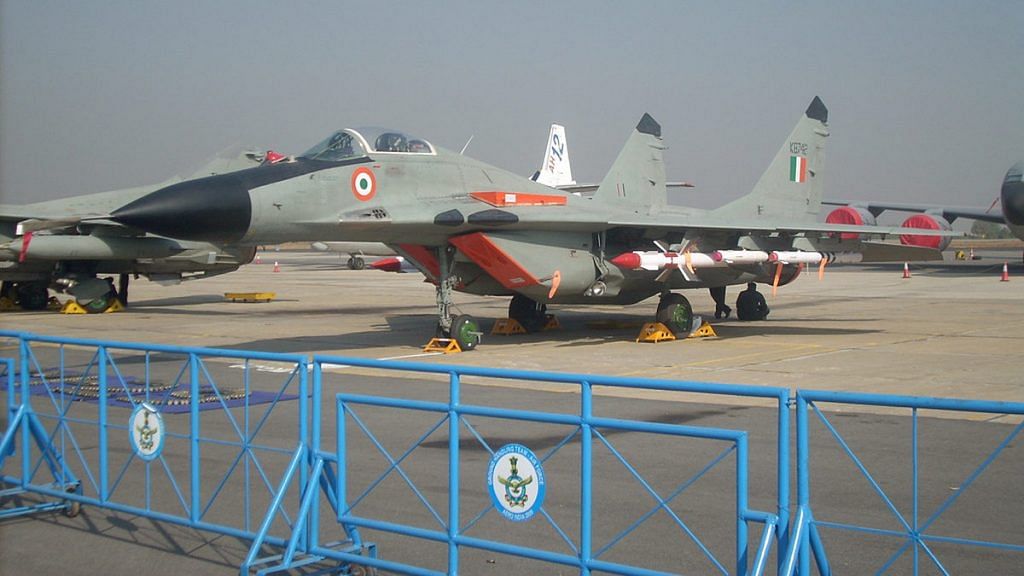New Delhi: The Indian Air Force has acquired the capability to fly its MiG-29 fighters at night from its Leh base in the future, at a time when India and China are taking steps towards disengagement at the Line of Actual Control in Ladakh.
Sources in the IAF said the process of night-flying, which has already begun, would be a “game-changer” because training by night will strengthen its capability to conduct full-spectrum operations at the Line of Actual Control on short notice, given Leh’s proximity to the LAC.
The new capability is fuelled by upgrades to the MiG-29, including advanced avionics, and faster and more extensive training of IAF pilots among other factors.
Leh is not a permanent fighter base, but detachments of aircraft are sent there on a regular basis.
An IAF officer said the MiG-29s are carrying out extensive, round-the-clock flying from Leh, which will also help the force validate geospatial data to enhance its capabilities in night operations.
Fighters such as the Sukhoi Su-30s conduct night operations in the Leh and Ladakh regions, but they come from other bases that have night capabilities. Apache and Chinook helicopters also carry out night-time operations.
Also read: How IAF has played a critical role in the India-China stand-off at Ladakh
Significance of the new capability
Senior IAF officers explained that in modern warfare, most operations are carried out at night, for two reasons.
“The first reason is that there are chances of the enemy being comparatively less alert during the night. Secondly, there is less chance of visual detection of the aircraft, which helps in surprising the enemy,” an IAF officer said.
An aircraft can be detected visually and by radars. Flying at night cuts down the visual spectrum of detection.
A second officer explained that Chinese airfields in the LAC region near Ladakh are at a higher altitude than Leh, and thus, their load carrying capacity is lower, while fighters operating from Leh airbase can have a higher load-carrying capacity.
“This gives India a strategic advantage too, both in day and night flying,” the second officer said.
A 2013 policy brief written by Air Marshal V.K. Bhatia on ‘Air Power Across the Himalayas: A Military Appreciation of Indian and Chinese Air Forces’ noted that if the People’s Liberation Army Air Force (PLAAF) was to operate from its well-established bases at Khotan, Kashgar, Golmud etc., it would have to operate from much greater distances to reach the IAF airfields, resulting in reduced payloads and possible requirement of in-flight refuelling etc.
Bhatia’s brief stated that the IAF could easily reach its airfield targets in Tibet from its main bases strung around the entire Indo-Tibetan boundary without any payload or other penalties.
However, an NDTV report said China had initiated massive construction activity at the high altitude Ngari Gunsa air base — a dual-use airport located at 14,022 feet altitude and serving the town of Shiquanhe, about 200 km from the Pangong lake.
Night flying in the mountains
IAF officers also explained why night flying is difficult in the mountains, as high altitude and rarefied air limit manoeuvrability and capability of an aircraft.
“The undulating and hazardous terrain and rapidly-changing weather conditions at such high altitude are fraught with risks,” an officer explained, adding that the “depth perception” is not there while flying at night. “Also, there is a delayed engine response at high altitudes.”
The officer added: “Take-off, landing and flying in the hills at night would require a combination of both visual flight rules and instrument flight rules, which is a skill set acquired by pilots with extensive training. This has been happening since the IAF has been preparing for a contingency.”
Also read: China ‘deploys’ S-400s, IAF has war gamed the scenario multiple times for air ops
